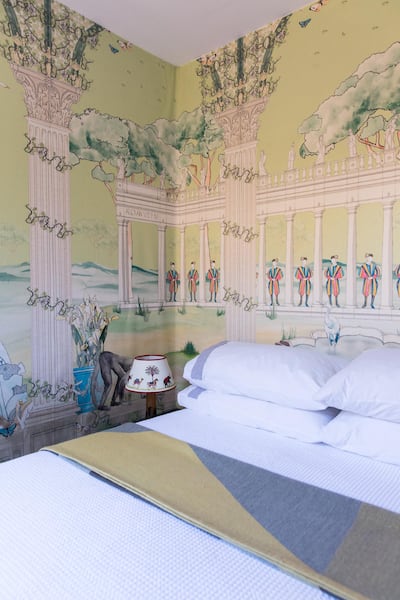Roi du Lac’s creations offer a vibrant journey through time and place: birds of paradise, Egyptian pharaohs and even an errant hippo appear on bomber jackets, blazers and dresses.
Tutankhamun’s gold death mask stares out from T-shirts; emerald-hued scarabs scuttle across cigarette-cut trousers; and panoramic scenes from Japan, Rome, Turkey and Mexico sing from wallpaper, cushion covers, plates and espresso cups.
These are the artistic musings of Scottish-Italian creative director Marco Kinloch, who founded the brand with his Italian wife, Princess Antea Brugnoni Alliata, in 2016, while they were restoring the latter’s ancestral home.
“We started with wallpaper, which coincided with the fact that we were trying to restore my family’s historic home in Sicily, which dates back to the beginning of the 18th century and needed heavy restoration work, especially with regards to the older silks on the walls and the fabrics that were used as wall coverings,” Princess Antea explains.
From wallpaper, they moved into home accessories and, eventually, ready-to-wear, with Kinloch’s bold prints and intriguing colour combinations acting as a thread that weaves through the collections.
After selling their products in speciality shops around the world, in September, in the midst of the global pandemic, they opened their first stand-alone boutique in Rome, to provide what Princess Antea describes as “a little moment of joy”.
Recent trunk shows in Dubai and with Aïshti in Beirut are part of efforts to introduce the brand to new, sophisticated markets that appreciate the quality and aesthetics of Roi du Lac’s creations.
Each item is produced in Italy, from the finest natural materials, in the brand’s own manufacturing facility, by people who are rightfully employed.
“The more we grow the brand, the more we realise we need to direct ourselves to a sophisticated clientele, who realises the importance of materials and the quality of what’s behind the product. I think it’s fundamental to focus on the fact that the fabrics are natural, and the Middle Eastern market is very sensitive to this issue. They have a traditional knowledge about fabrics,” says Princess Antea.

She recognises that times of crisis can also provide moments of strong opportunity, not only for Roi du Lac, but for the wider fashion industry.
“We have an opportunity to disconnect the brand and the final consumer from the craziness of the fashion marketing industry. We should focus more on that relationship with the consumer and on making a product that is worth what the customer is paying, and that adds aesthetic value to the life of the customer.”
The consumer needs to be moved back to the centre of the fashion equation, which is why Roi du Lac offers clothes that are customisable and in a range of sizes.
“Somehow, we’ve gone from a moment in the time of fashion when a designer was appreciated because he knew how to cut fabrics in order to emphasise the beauty of a certain body. We went from that to: ‘How do I make sure that my body is so thin that it will fit into a certain designer’s clothing?’
“I see this with our clients. She will be trying something on and she’ll say: ‘Oh this is not going to fit me, it’s not the right shape for me.’ And I’ll say: ‘Just try it on and if it’s not the right fit for you, we’ll make it the right fit.’
"We are the ones who are supposed to provide a service to you. You are not supposed to adapt your body to us.”

There is a growing trend of professional women buying Roi du Lac’s colourful prints to wear in the workplace, which Princess Antea sees as a conscious move away from women in high-powered corporate jobs feeling like they have to mimic the sombre dress codes of their male counterparts in order to be taken seriously. The brand’s customers are shedding the trousers suits for sumptuous silk shirts in myriad hues.
While Kinloch has been drawing since he was a child, he is entirely self-taught, which renders his creations both familiar and unique.
“In his vision, there is this overlaying of two and three-dimensional items. It is not a realistic way of drawing, and I think this is what adds to the elegance of the product, because it gives it this kind of older, more naive, more 1800s way of interpreting things, figures and images.”
His drawings hark back to the age of the 19th-century traveller, returning to Europe with a new-found appreciation of the world around him. But while Roi du Lac’s products are a celebration of history and multiculturalism, Princess Antea is sensitive to the issue of cultural appropriation.
“We are, in Europe, at the crossroads of civilisations, and our brand expresses that intense admiration and fascination for other cultures. So you will see references to Japan in the Edo period, or Mexico as seen through the eyes of Diego Rivera, or the Mughal Empire and Islamic India, and the idea of this extremely sophisticated empire that was really connecting East and West," she explains.
“We are celebrating a European tradition of multicultural relationships. I use the example of muqarnas, the Spanish wooden ceiling, which is actually an Islamic wooden ceiling, brought by the Arabs during their ruling of Spain. All the most important buildings are decorating in this way.
"But if you go to Quito in Ecuador, in the most important cathedral, you will find the same ceilings. Because when the Spanish conquered South America, they used the architecture they knew. So the history of Europe is a history of mutual enrichment. You can not take that away.”





